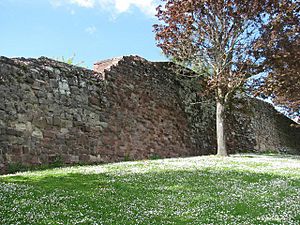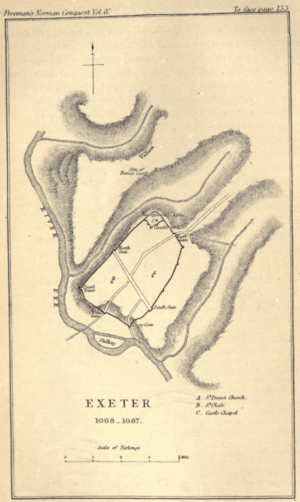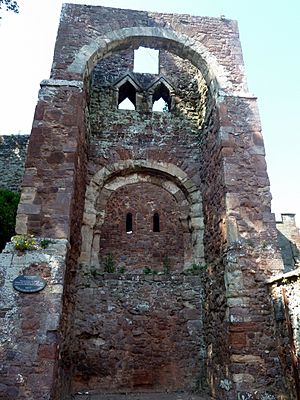Siege of Exeter (1068) facts for kids
Quick facts for kids Siege of Exeter |
|||||||
|---|---|---|---|---|---|---|---|
| Part of Norman conquest of England | |||||||
 Part of the Exeter's Roman city wall, repaired and defended by the English in 1068. |
|||||||
|
|||||||
| Belligerents | |||||||
| Exonian rebels and allies from other nearby cities | Royal forces | ||||||
| Commanders and leaders | |||||||
| Gytha Thorkelsdóttir | William I of England | ||||||
| Strength | |||||||
| Much of Exeter's population and allies from other local towns | Initially 500 Norman cavalry supported by English fyrd infantry | ||||||
The siege of Exeter happened in early 1068. King William I of England led his army, made up of Normans and loyal Englishmen, to the city of Exeter in Devon. Exeter was a strong place for Anglo-Saxon people who resisted Norman rule after the Norman Conquest of England. After a siege that lasted eighteen days, the city gave up to William. He offered fair terms. This helped the Normans take stronger control over the West Country area of England.
Contents
Why Did the Siege Happen?
Exeter's History as a Fortified City
Exeter started as a Roman town called Isca Dumnoniorum. It got its first town walls around 200 AD. Later, it became an Anglo-Saxon burh, which means a fortified settlement. King Æthelstan was said to have fixed and improved these Roman walls in the 900s. This made Exeter a very strong place.
The Resistance Against William
After the Battle of Hastings in October 1066, Duke William of Normandy became King of England. He was crowned at Westminster Abbey on Christmas Day. Harold Godwinson, the English king, died at Hastings. His mother, Gytha Thorkelsdóttir, went to Exeter for safety. Exeter then became the main center of resistance against Norman rule in the West Country.
Gytha was very rich. She hoped her grandsons, Harold's sons Godwin, Edmund, and Magnus, would come from Ireland with an army. She sent messages to other towns asking for help. She also talked with her nephew, Sweyn II of Denmark.

William's Demand and Exeter's Refusal
In March 1067, William went back to Normandy. But news reached him about Exeter. Some Norman soldiers had been badly treated there. They might have been on a spying mission. This, plus Exeter trying to start a rebellion, made William demand loyalty from the city.
Exeter's answer was clear: they would not promise loyalty to William. They would not let him enter their city. They also refused to pay new, higher taxes. They only wanted to pay the old, usual taxes. William said he would not accept subjects under these terms. He returned to England in December 1067. Exeter's defiance was a big problem for William.
William Marches West
King William spent Christmas in London. Then he started his march towards Exeter. He decided to campaign in winter, which was unusual. This showed how determined William was to stop Harold's sons from gaining power.
For the first time, William added English foot soldiers, called the fyrd, to his Norman cavalry. This made his army bigger. It also tested the loyalty of his new English subjects. As William marched through Dorset, he attacked towns that seemed to support Exeter. Towns like Dorchester, Shaftesbury, and Bridport were badly damaged. This damage was still clear 18 years later.
The Siege of Exeter
Arrival at Exeter
When William reached Exeter, he set up camp. It was probably near the village of Clyst Honiton. Some important citizens from Exeter came to meet William. They promised to surrender and gave him hostages as a guarantee.
Historians have two ideas about this meeting. One idea is that people in Exeter were split. Some wanted peace, while others, led by Gytha, wanted to fight. The second idea is that Gytha was pretending to surrender to gain time. She hoped her grandsons would arrive with an army.
Whatever the reason, when William and his army reached Exeter's East Gate, it was closed. Armed men stood on the walls. William was angry. He had one of the hostages blinded in front of the city's defenders. But this did not make them give up. One man on the wall even made a rude gesture towards the Normans.
Fighting and Surrender
Different historical accounts tell slightly different stories about the siege. The Anglo-Saxon Chronicle says the siege lasted eighteen days. William's army lost many soldiers, probably from direct attacks.
At some point, Gytha escaped from the city by boat along the River Exe. Some of her supporters went with her. This shows that William's army did not have ships blocking the river. One historian, Orderic, says William eventually broke through the walls by mining. This was the first time this technique was recorded in England.
However, the siege ended with talks, not a full conquest. Orderic says the gates were opened. The townspeople, led by their priests with holy books, begged for mercy. All sources agree that William offered generous terms. The Chronicle adds that he agreed to their old request to pay taxes only at pre-Conquest levels. William also stopped his soldiers from looting the city, which was a common right after a surrender. He put guards at the gates to keep the city safe.
What Happened Next?
Building Rougemont Castle
William ordered a stone castle to be built to control Exeter. Rougemont Castle was built inside the northeast part of the city wall. William's unusual kindness at Exeter might have been because he needed to control the West Country quickly.
One historian thought that Condor of Cornwall, a local leader, might have helped the rebels. He lost his title because of this. After Exeter, William marched his army into Cornwall. This was a show of strength. Then he went back to Winchester to celebrate Easter.
A Norman knight named William de Vauville first commanded Exeter's soldiers. Soon, Baldwin FitzGilbert took over. Brian of Brittany was made the earl of the West Country.
Gytha's Escape and Harold's Sons
Gytha and her group sailed from Exeter to the Bristol Channel. She set up a base on the island of Flat Holm. She might have hoped to meet her grandsons' army from Ireland there. Eventually, she went to Saint-Omer in Flanders. She had been exiled there before with her husband, Godwin, Earl of Wessex, in 1051. She never came back to England.
Harold's sons did not arrive until later that year. The people of Bristol closed their gates to them. They were later defeated at Bleadon by an English earl named Eadnoth the Staller, who died in the fight. Harold's sons tried to invade Devon again in 1069. But Exeter stayed loyal to William and did not help them.



